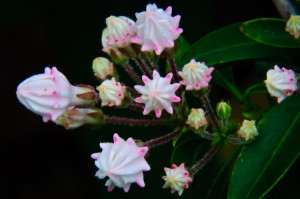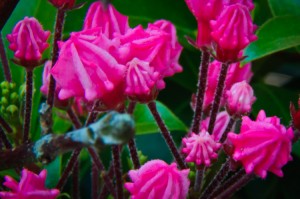 One of my all-time favorite mountain wildflowers is the mountain laurel. This flower is complex, both in physical form and in coloration, and the changes which occur from bud break to full flower are fairly amazing to the interested observer. The new buds, shown in the image here, are enclosed bulbs with crinkles and folds along the sides with no visible structures which might accommodate pollination. As the flowers develop, the enclosed bulb opens up to display a complex structure that includes a trigger mechanism which is tripped by bees or butterflies so that the pollen is thrown onto the pollinator insect. I’ll post some images of the full flower as they develop in a few more days.
One of my all-time favorite mountain wildflowers is the mountain laurel. This flower is complex, both in physical form and in coloration, and the changes which occur from bud break to full flower are fairly amazing to the interested observer. The new buds, shown in the image here, are enclosed bulbs with crinkles and folds along the sides with no visible structures which might accommodate pollination. As the flowers develop, the enclosed bulb opens up to display a complex structure that includes a trigger mechanism which is tripped by bees or butterflies so that the pollen is thrown onto the pollinator insect. I’ll post some images of the full flower as they develop in a few more days.
 The mountain laurel is widely distributed throughout our area and is available for purchase at most nursery and landscaping suppliers here in the NC High Country. Varieties of color are available, ranging from the white-with-touch-of-red varieties which are most often found along the Blue Ridge Parkway to a full red variety which I have not seen in the wild. I have both in my home landscape, planted on the East side of my home in an area that receives morning sun and is protected from the vicious winter winds which are common here. My experience has been that these shrubs are not as hardy as rhododendrons and do not thrive when exposed to the wind.
The mountain laurel is widely distributed throughout our area and is available for purchase at most nursery and landscaping suppliers here in the NC High Country. Varieties of color are available, ranging from the white-with-touch-of-red varieties which are most often found along the Blue Ridge Parkway to a full red variety which I have not seen in the wild. I have both in my home landscape, planted on the East side of my home in an area that receives morning sun and is protected from the vicious winter winds which are common here. My experience has been that these shrubs are not as hardy as rhododendrons and do not thrive when exposed to the wind.
These images are extreme close-ups, made using a Nikon D300 camera with a Nikkor 70-200mm zoom lens set at 200mm. The setup also includes a 1.7x teleconverter to multiply the focal length to 340mm and a set of extension tubes placed between the lens and the camera body. The effect of the extension tubes is to bring the point of focus closer and to generate a larger image on the sensor. With this arrangement I am able to produce an image which is greater than life size on the camera sensor. There are limitations, of course, in this process. A tripod is essential, as is a wind-free environment (try finding that in Boone!) because of the long exposures required. Manual focus is required but automatic exposure is still available even though light levels are reduced. I look forward to using this technique and the equipment described here to document the development of the mountain laurel flowers. Look for updates in future postings here.
About Tom
Professor Emeritus of Chemistry, Appalachian State University.

Mountain Laurel
These images are extreme close-ups, made using a Nikon D300 camera with a Nikkor 70-200mm zoom lens set at 200mm. The setup also includes a 1.7x teleconverter to multiply the focal length to 340mm and a set of extension tubes placed between the lens and the camera body. The effect of the extension tubes is to bring the point of focus closer and to generate a larger image on the sensor. With this arrangement I am able to produce an image which is greater than life size on the camera sensor. There are limitations, of course, in this process. A tripod is essential, as is a wind-free environment (try finding that in Boone!) because of the long exposures required. Manual focus is required but automatic exposure is still available even though light levels are reduced. I look forward to using this technique and the equipment described here to document the development of the mountain laurel flowers. Look for updates in future postings here.
About Tom
Professor Emeritus of Chemistry, Appalachian State University.